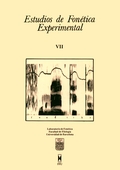La invariación acústica: introducción
Abstract
The obvious variation of F2 transitions for equal place of articulation, due to the influence of the following vowel, provided Liberman et col. (1967) with evidence against the existence of invariant acoustic parameters in speech perception. They claimed that there was invariance in the motor mechanisms of speech production. However, Stevense's quantal theory (1972) and the phenomenon of categorical perception made it clear that the articulatory cavities produce steady acoustic patterns which can be captured by the human perceptive system, thus limiting substantially the number of phonic patterns that can be used in a language. So then, these restrictions support the existence of acoustic invariant cues that can be processed by the human perceptive system. Having this hypothesis as basis, we have carried out various studies seeking invariant acoustic parameters for the sounds of Spanish, with the aim that this will serve us to implement an automatic speech recognition model based on phonetic features.
Downloads
Published
How to Cite
Issue
Section
License

This work is licensed under a Creative Commons Attribution-NonCommercial-NoDerivatives 4.0 International License.
All articles published online by Estudios de Fonética Experimental are licensed under Creative Commons Attribution-NonCommercial-NoDerivs 4.0 International (CC BY-NC-ND 4.0 DEED), unless otherwise noted. Estudios de Fonética Experimental is an open access journal. Estudios de Fonética Experimental is hosted by RCUB (Revistes Científiques de la Universitat de Barcelona), powered by Open Journal Systems (OJS) software. The copyright is not transferred to the journal: authors hold the copyright and publishing rights without restrictions. The author is free to use and distribute pre and post-prints versions of his/her article. However, preprint versions are regarded as a work-in-progress version used as internal communication with the authors, and we prefer to share postprint versions.




